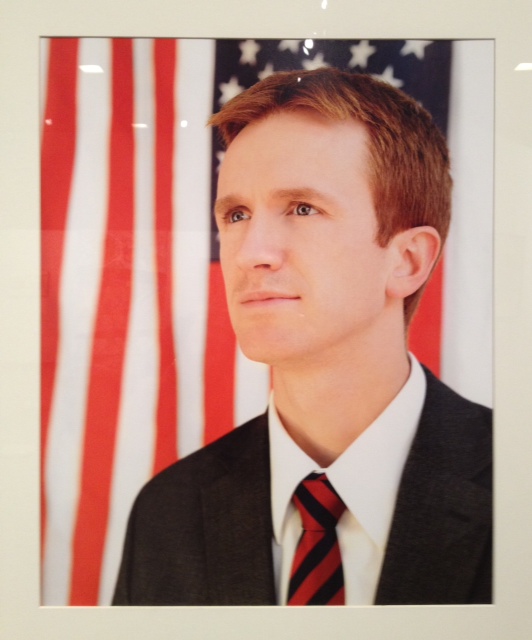With personalities from sixteen artists comes stark diversity and when given a provocative subject for an exhibition, the emanating work should be broad and capture a core of honesty. “E Pluribus Unum” is now showing at Tippetts Gallery at Utah State. The meaning of the motto is; “Out of the many comes one.” A goal of this show hopes the range of art produced by the sixteen will resonate as one united voice. This indicates that many can assert personal individuality while contributing harmoniously to a collective whole. This may prove demonstrative, with quantifiable results, of the current national partisan situation, anticipating a forthcoming crossroads of history.
A telling piece is by Daniel T. Barney and Randal Marsh (pictured) “Untitled (Poll, 2012).” A polling booth stands against a wall with a curtain behind and a lofty image of one candidate to either side. Beneath each portrait is a mock ballot. We read of nonsensical categories each are judged on such as “Basic Attributes” including dexterity and fatigue. “Lifting and Moving” come into play as a category and “(Dis)Advantages” are weighed heavily. The last category is “Skills” with useless qualifiers such as gardening.
This farce is a loaded demonstration of how generally uniformed or misinformed the public can be of the candidates for whatever reason or reasons. Instead of real partisan difference and disunion, a fabricated sense of blind partisan loyalty seems plausible. This ironic artistic cry is for “E Pluribus Unum!”
From conceptual artist Namon Bills comes a seminal installation piece “False Dichotomy.” With torched raised, Lady Liberty lights the path of freedom to the “huddled masses” of history. This 2-D sculptural collaged replica of the Statue of Liberty with a chess set sets the stage for social, political and economic conceptual interpretation from a mapping of visual signifiers, revealing polemics of today’s “masses.”
The history of the statue juxtaposed by the collaged techno-data smattered across it, the duality between traditional purposes of the statue and America in a globalized society and economy, and a game of chess alluding to political parties with myriad differences that accompany them, are just some of the polemics. Yet the entirety is balanced. It is only ignorance, akin to uninformed political coercion, that distorts and corrupts the conceptual purposes of this installation. Another artist cries “E Pluribus Unum!” in a show where, for the most part, many personal and impassioned individuals unite harmoniously with a lesson for a more universal and imperative national spectrum.
